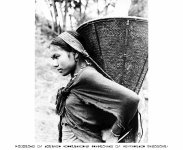Anyone ever try the old system of portaging gear that involved using a ground cloth or tarp as the actual pack carried with a tumpline? Like this:

You frequently see these pack cloth rolls in older paintings, especially Philip Goodwin's canoe-themed artwork:
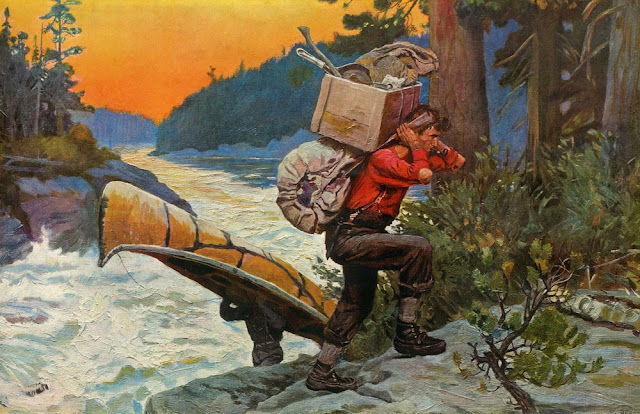
It seems that by the time many camping books of the early 1900s began being published, this method was being replaced by "modern" canvas packsacks like the Poirier (a.k.a. Duluth Pack) which have themselves been relegated to outdated gear by lots of folks. Of course this system will never be as waterproof as modern canoe packs or as comfortable as padded shoulder straps and hip belt supports, but I like the concept using the tarp for more than one role (i.e. shelter) and doing away with a pack entirely. The most descriptive method I found explaining this packing method is in Woods and Lakes of Maine (1883) by Lucius Hubbard, viewable online at archive.org. Page 102 devotes a few paragraphs describing the bundling technique used by his guides along with the following illustration:

Awesome adventures like Alan's Bloodvein expedition or Memaquay's Marshall Lake gathering or Tear_knee's Temagami trip are just not going to happen for me at the moment. At that stage in life where family responsibilities are taking up all of the potential tripping time. Figured a solution to that somewhat depressing fact would be nice some tinkering around with old timey gear relegated to the history books. Don't have any intentions of a "real" canoe trip with this method, but had made plans to give it a whirl and a quick and safe outing.
My birthday present this year was free time to spend one night camping away from the family...so long as it wasn't too far. The plan was to paddle to the other end of my cottage lake where some undeveloped land has been set aside by generous locals for an overnight camps & picnics. Still within cell phone range and could be back home in an hour and half so got the green light to go from the boss of the family.
As a bit of trial run, I packed up my ground sleeping system which consists of a modern pad, down sleeping bag, extra blanket, canvas bedroll cover and a 6x8' poly tarp as a groundcloth - sort of a mix of new and older stuff. The tumpline is the one made last winter for an accompanying wanigan - it is plenty long with 9' tails. Here are some pics that show the attempt at the packing method.
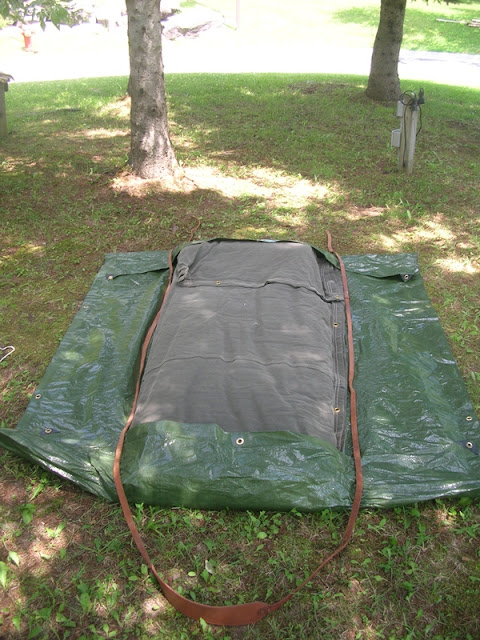
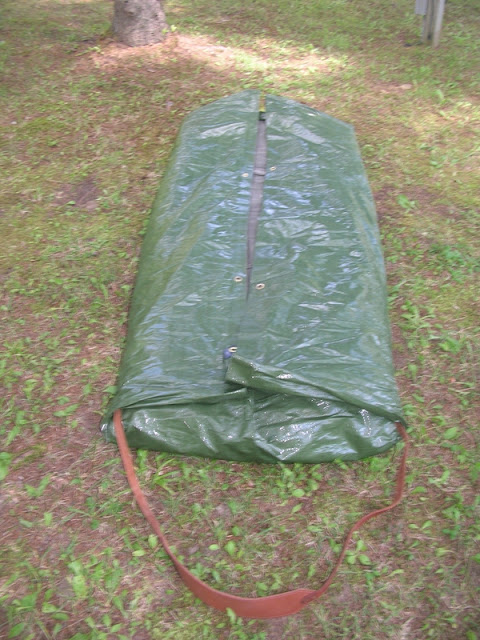
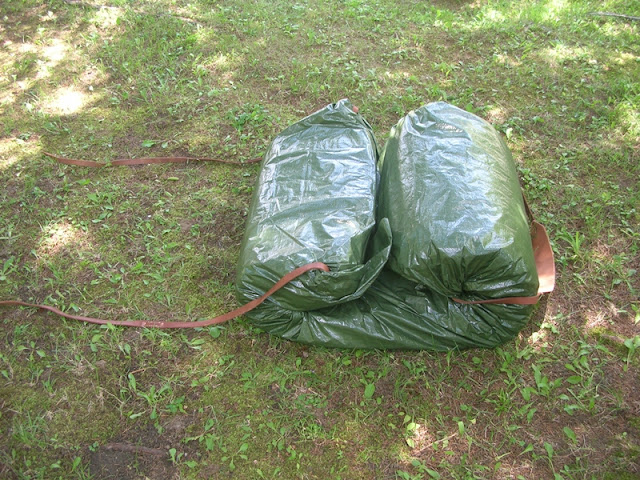
If folded correctly (i.e. not rolled from head to foot), you pull hard on the excess tails of the tumpline while holding the headstrap and the sides cinch up like the drawstring on an open bag. It tightens everything up nicely. Cross the lines, tie off and you end up with a neat bundle:

The pack roll fit well enough into the canoe along with the wanigan loaded with food, birthday happy-time beverages and other miscellaneous gear.
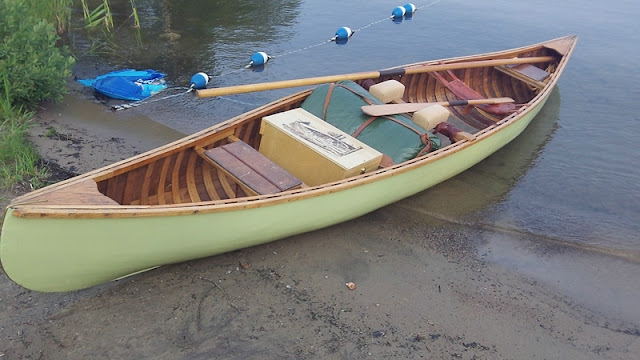
Part of the shoreline is shallow rock and sand so it's great for poling practice too. Ended up splashing round a bit and the poly ground cloth did its job keeping everything dry, but of course wouldn't trust this method entirely if a full submersion took place.
Halfway there and feeling excitment that I'm back in the boat, the cell phone rings. Minor emergency but needed back home right away...arghhh! 45 minutes of "tripping" on an urbanized cottage lake is all I got in this season.
Here is the only action shot while on the water. A standup view while poling in a shallow bay right before the dreaded phone call.

Apologies for all the self-pity seeping through the post. Life is good. Just wanted to end by saying that trip reports by other folks are most appreciated when you're stuck in civilization!

You frequently see these pack cloth rolls in older paintings, especially Philip Goodwin's canoe-themed artwork:

Cruisers Making a Portage
It seems that by the time many camping books of the early 1900s began being published, this method was being replaced by "modern" canvas packsacks like the Poirier (a.k.a. Duluth Pack) which have themselves been relegated to outdated gear by lots of folks. Of course this system will never be as waterproof as modern canoe packs or as comfortable as padded shoulder straps and hip belt supports, but I like the concept using the tarp for more than one role (i.e. shelter) and doing away with a pack entirely. The most descriptive method I found explaining this packing method is in Woods and Lakes of Maine (1883) by Lucius Hubbard, viewable online at archive.org. Page 102 devotes a few paragraphs describing the bundling technique used by his guides along with the following illustration:

Awesome adventures like Alan's Bloodvein expedition or Memaquay's Marshall Lake gathering or Tear_knee's Temagami trip are just not going to happen for me at the moment. At that stage in life where family responsibilities are taking up all of the potential tripping time. Figured a solution to that somewhat depressing fact would be nice some tinkering around with old timey gear relegated to the history books. Don't have any intentions of a "real" canoe trip with this method, but had made plans to give it a whirl and a quick and safe outing.
My birthday present this year was free time to spend one night camping away from the family...so long as it wasn't too far. The plan was to paddle to the other end of my cottage lake where some undeveloped land has been set aside by generous locals for an overnight camps & picnics. Still within cell phone range and could be back home in an hour and half so got the green light to go from the boss of the family.
As a bit of trial run, I packed up my ground sleeping system which consists of a modern pad, down sleeping bag, extra blanket, canvas bedroll cover and a 6x8' poly tarp as a groundcloth - sort of a mix of new and older stuff. The tumpline is the one made last winter for an accompanying wanigan - it is plenty long with 9' tails. Here are some pics that show the attempt at the packing method.



If folded correctly (i.e. not rolled from head to foot), you pull hard on the excess tails of the tumpline while holding the headstrap and the sides cinch up like the drawstring on an open bag. It tightens everything up nicely. Cross the lines, tie off and you end up with a neat bundle:

The pack roll fit well enough into the canoe along with the wanigan loaded with food, birthday happy-time beverages and other miscellaneous gear.

Part of the shoreline is shallow rock and sand so it's great for poling practice too. Ended up splashing round a bit and the poly ground cloth did its job keeping everything dry, but of course wouldn't trust this method entirely if a full submersion took place.
Halfway there and feeling excitment that I'm back in the boat, the cell phone rings. Minor emergency but needed back home right away...arghhh! 45 minutes of "tripping" on an urbanized cottage lake is all I got in this season.
Here is the only action shot while on the water. A standup view while poling in a shallow bay right before the dreaded phone call.

Apologies for all the self-pity seeping through the post. Life is good. Just wanted to end by saying that trip reports by other folks are most appreciated when you're stuck in civilization!








